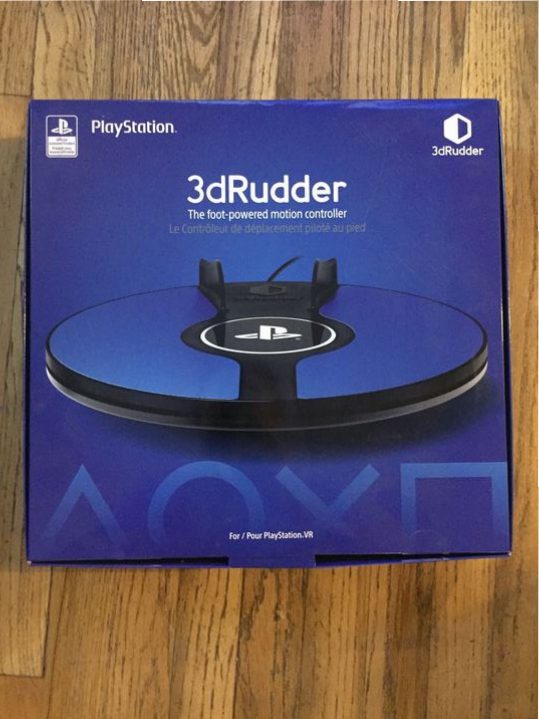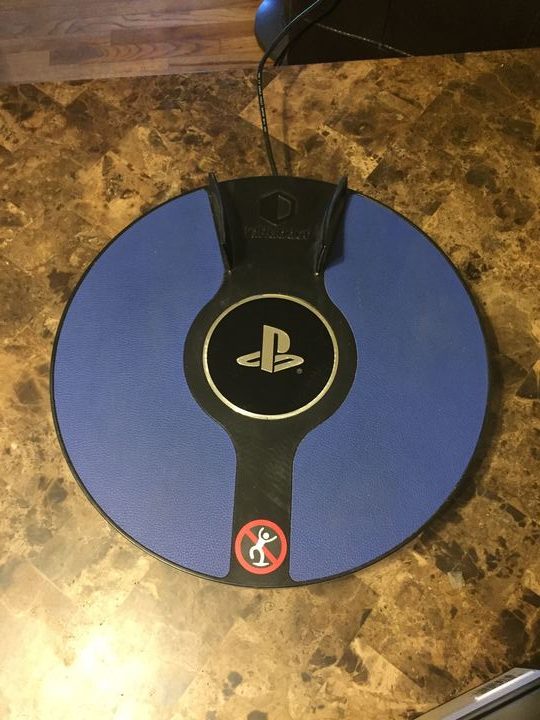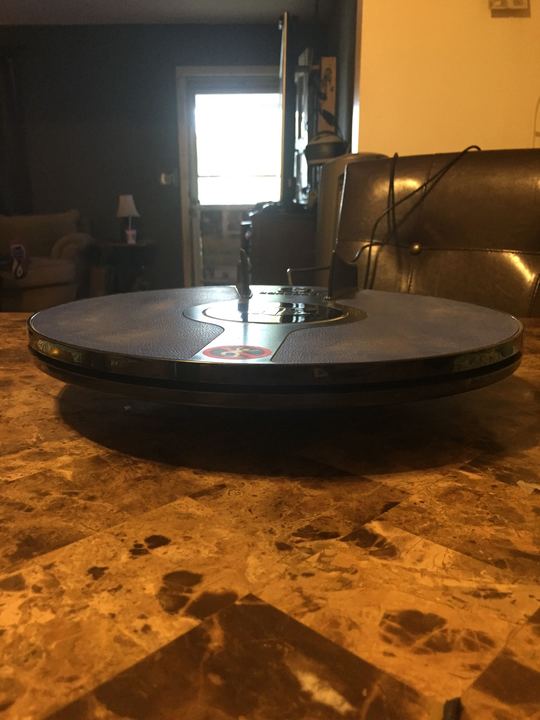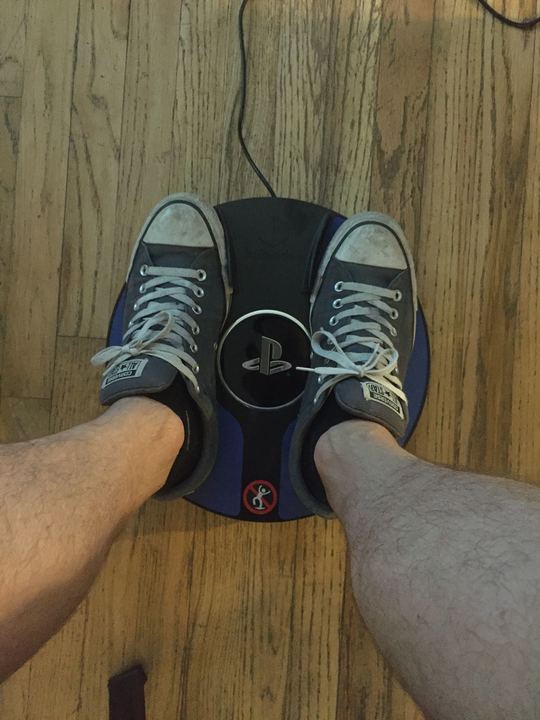If you read any of my stuff here at Pure PlayStation, then you know that I love the PSVR. It has its warts for sure, and I don’t overlook them or pretend they aren’t there, but I don’t let them ruin an otherwise awesome experience. The source of these problems stems mostly from the outdated tech that the PlayStation VR was built around. The light-based system and generation-old Move controllers have been drug through the mud since the PSVR launch, and mostly for good reason. It’s no secret that light-based tracking can be tricky under certain conditions. I’m lucky in that I have a near-perfect place to set up. A large room with dark walls and blackout curtains that virtually kill sunlight. Five strategically placed hooks in the ceiling to hang my retractable cable holders and I have effectively given myself the best chance to have a good time with my VR rig of choice. Be it my setup or just plain dumb luck, but I can honestly say I’ve never suffered from Aim drift through a hundred hours of Firewall Zero Hour and Farpoint. That’s not to say I don’t have to give it a shake to straighten it out from time to time, but I’ve seen videos of Aim Controllers drifting across the screen, and I know I’m lucky.
But tracking isn’t the only shortcoming of the PSVR, and more specifically, the Move controllers. Of course, I’m talking about the absence of analog sticks. I know most of us have become experts at the “Skyrim” style locomotion system. You know the one, pointing the move in the direction you want to walk and pressing the large Move button in the middle. It’s not ideal, obviously, but it beats teleportation, am I right? It works well, but no matter how adepts one gets with this system when the action gets intense, it just can’t give you that precision we’ve all grown accustomed to. Enter the 3DRudder.

The 3DRudder aims to solve possibly two of the largest hurdles that the PSVR has to enter the mainstream. First, and most obvious, is the lack of thumbsticks on the Move controllers. As you probably figured out by the pictures, the 3DRudder maps all character movement to your feet. You simply tilt the Rudder forward to move forward and tilt it back to back up. You can strafe left and right by tilting in the direction you want to go and you can turn left or right by rotating it in either direction. It’s a simple design that smartly uses your legs to move your character. This does two things in theory: it unburdens your hands for activities that you would actually do with your hands, such as shooting a gun or summoning spells, and it could also help curb the motion sickness felt by some in VR by making your legs and feet control your movement. But does it accomplish either of those things? I played a handful of the games that are available with the 3DRudder and I’ll do my best to answer those questions.
Of the 30 available games, I’ve played only The Immortal Legacy, The Wizard, Sairento, The Mage’s Tale, and Scraper: First Strike. I wish I could have tested more, but I don’t own the other games because, for whatever reason, they never interested me. But for the sake of thoroughness, here are the other games currently compatible according to the 3DRudder website:
Wolfenstein: Cyber Pilot, Witching Tower, Space Junkies, Telefrag VR, Beat Blaster, Xing: The Land Beyond, Red Matter, Intruders: Hide and Seek, Operation Warcade, Mind Labyrinth, Honor and Duty: D-Day, Bow to Blood, Ultrawings, Verti-go Home, TrainerVR, and Pirate Flight. Current titles Blind, Affected: The Manor, CoolPaint VR, and Transpose are all working on adding 3DRudder support. In addition, greatly anticipated games such as Undead Citadel, Shadow Legend, Touring Karts, Proze: Enlightenment, Nature Treks VR, and the promising Contagion VR: Outbreak all will support this interesting piece of kit.

Of the games I’ve tested, let’s start with a popular VR exclusive that I reviewed a while back, The Wizards. I enjoyed the game with the Move controllers, but the best part of the game, the hand gesture-based spells, made moving during combat a pain. It was nearly impossible to backpedal while attacking at the same time, which is a staple to my playstyle. I don’t know what that says about me, but it probably isn’t great. Either way, it was frustrating and definitely hindered the fun. The 3D Rudder changed all of that. Yes, I had to sit down, but freeing up my hands to do only “hand” things was a revelation. I am not here to convert those who refuse to sit down in a VR game where your character is standing, but if you don’t mind sitting during your VR adventures, then the 3DRudder absolutely makes The Wizards more fun.
The same is true about Sairento VR. I didn’t have as much frustration with the Move controllers in Sairento as I did with The Wizards, but moving about this ninjaesque adventure with the 3DRudder worked really well.
Next up is my favorite, Immortal Legacy: Jade Cypher. Immortal Legacy is a strange game that plays like a VR Uncharted. It featured an incredibly difficult control scheme that caused a lot of players to give up on it. I still enjoyed the game, but the 3D Rudder made it so much better. Walking freely while keeping both hands available for duel wielding weapons/flashlights and managing inventory was a game-changer. Another standout for me was Scraper: First Strike. This is a sci-fi adventure game with some RPG elements, but you spend the entire game seated as you pilot some kind of futuristic battle pod. It’s the one game where the 3D Rudder actually increases the spacial immersion. It actually feels like you are driving this crazy space machine.

It’s not all roses, however. The Mage’s Tale, a fun little dungeon crawler I reviewed at launch, feels a little disjointed. It’s a not so subtle reminder that when it comes to virtual reality, if the optimization isn’t just right, be prepared to feel some nausea. In the case of The Mage’s Tale, I couldn’t quite tell what was off. The movement speed, the turning speed, or something else, but I couldn’t get it where I wanted it. I’m not sure if that’s on me, or the developer who patched the 3DRudder controls in. Either way, it’s the one game where the 3DRudder didn’t improve my experience.
With just a USB plugin, it’s easy to set up, but it could be a bit finicky. At one point it stopped working in Scraper: First Strike, leaving me stuck in an elevator. I could still turn but I couldn’t move forward or backward. I eventually had to shut the game off and restart. I found a few other quirks like that but nothing that was a real deal-breaker. Some users complained of the Rudder sliding around on them, but I didn’t have that problem. I used the mat that came with it and placed it directly on my wood floor. They make a separate base that may come in handy if you play on carpet, but that also adds more investment for an already expensive add on. But the biggest problem for me is game adoption. I want to play Skyrim with this thing. Where is Borderlands? Arizona Sunshine, Doom, No Man’s Sky, etc.

It’s an interesting, if albeit imperfect, solution to the PSVR movement problem. It’s a bit pricey, I don’t love adding more cords to my system, and the question about future game adoption is a real issue. For the most part, the 3DRudder does improve the games that utilize it, and that should be considered a big win. It didn’t help much with motion sickness for me, but I don’t suffer much from it, to begin with. It’s not a perfect answer to our PSVR locomotion issues, but it’s a viable option that is better than nothing and one I will continue to use.
3dRudder PSVR Review
-
Overall - Fantastic - 8/108/10
Summary

What all of this boils down to is this: is the 3dRudder worth the current asking price of $120? Would it be easier to recommend if that price was, say, $79? Hell yes, it would, but as of now, I’m afraid the 3DRudder isn’t going to be for everybody. But if you’re interested in playing any of the games on the list above and don’t mind dropping a few more coins on your expensive VR habit, then you probably won’t be disappointed. And if a few more of the big current games get Rudder support, and we get a steady diet of new games added to the list, then I may start to consider it a bargain.
Review Disclaimer: This review was carried out using a unit bought by the reviewer. For more information, please read our Review Policy.















